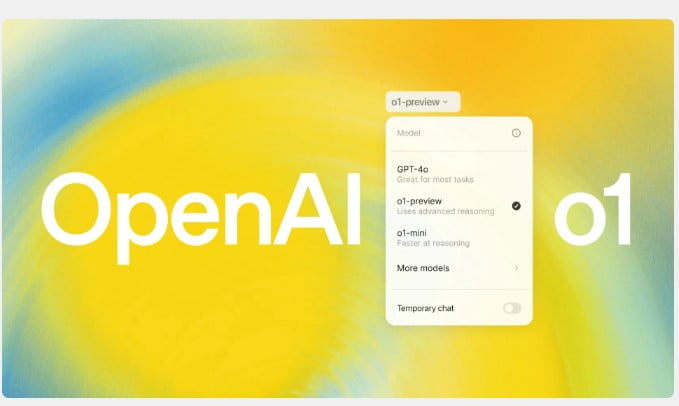Last Updated on September 18, 2024 12:30 pm by Laszlo Szabo / NowadAIs | Published on September 18, 2024 by Laszlo Szabo / NowadAIs
OpenAI o1: When AI Stops to Smell the Roses (and Think) – Key Notes
- OpenAI o1 models take time to “think” before responding, unlike instant-reply AI
- Excels at complex problems but can overanalyze simple queries
- Costs more due to “reasoning tokens” for hidden computational processes
Introducing OpenAI’s o1 Series
OpenAI has rewealed its latest innovation: the o1 series of AI models. Designed to revolutionize the way machines process information, these models are engineered to spend more time “thinking” before responding, a departure from traditional AI systems that generate instant replies.
The o1 series represents a significant milestone in OpenAI’s quest to develop more advanced and capable AI models. By introducing a deliberative approach, these models aim to tackle complex problems with greater precision and depth, potentially unlocking new frontiers in AI-driven reasoning and decision-making.
The Allure of Reasoned AI
The concept of “reasoned AI” has long been a tantalizing prospect for researchers and industry experts alike. While current AI models excel at specific tasks, their ability to engage in multi-step reasoning and break down intricate problems into smaller, manageable steps has been limited.
OpenAI’s o1 series promises to bridge this gap by incorporating a unique “thinking” process. By pausing to analyze and dissect complex queries, these models aim to identify potential pitfalls, consider alternative perspectives, and ultimately arrive at more comprehensive and well-rounded solutions.
Stepping into the Spotlight: o1’s Capabilities Unveiled
As the first glimpse into OpenAI’s reasoning-focused AI models, the o1 series has generated significant buzz within the AI community. Early assessments suggest that these models excel in tackling intricate questions and scenarios that demand a nuanced, multi-faceted approach.
One of the standout features of the o1 series is its ability to break down complex tasks into smaller, more manageable steps. By methodically working through each component, the model can identify potential roadblocks, weigh various factors, and ultimately provide a well-reasoned solution that considers multiple angles.
Navigating the Thanksgiving Conundrum: A Practical Application
To illustrate the power of o1’s reasoning capabilities, consider a scenario where the model was tasked with helping a family plan their Thanksgiving dinner. With multiple ovens available and a sizable guest list, the challenge involved determining whether additional oven space was necessary and weighing the pros and cons of renting an Airbnb for the occasion.
After a brief “thinking” period, the o1 model delivered a comprehensive 750-word response, meticulously outlining its thought process and considerations. It analyzed factors such as oven management strategies, cost implications, and the potential impact on family bonding time. Ultimately, the model concluded that two ovens would suffice with careful planning, eliminating the need for an additional rental and allowing the family to save money while maximizing quality time together.
Excelling at Complex Scenarios, Stumbling on Simplicity
While the o1 series shines in tackling intricate challenges, it appears to struggle with more straightforward queries. For instance, when asked a seemingly simple question about the locations of cedar trees in America, the model provided an unnecessarily detailed 800-word response, delving into scientific names and various subspecies.
This observation highlights a key limitation of the o1 series: its tendency to overthink and overanalyze even the most basic prompts. In contrast, its predecessor, GPT-4o, handled such queries with concise and direct responses, demonstrating a better grasp of when to provide succinct answers.
Tempering Expectations: o1 is Not AGI (Yet)
Amidst the excitement surrounding the o1 series, it’s crucial to temper expectations and clarify what these models are – and aren’t. OpenAI CEO Sam Altman has unequivocally stated that o1 is not an artificial general intelligence (AGI) system, dispelling any misconceptions or speculation to the contrary.
here is o1, a series of our most capable and aligned models yet:https://t.co/yzZGNN8HvD
o1 is still flawed, still limited, and it still seems more impressive on first use than it does after you spend more time with it. pic.twitter.com/Qs1HoSDOz1
— Sam Altman (@sama) September 12, 2024
While o1 represents a significant step forward in AI reasoning capabilities, it remains a specialized model with inherent limitations. Altman himself acknowledged that o1 is “still flawed, still limited”, and may initially seem more impressive than it does after extended use.
The Reasoning Revolution: Implications and Potential
Despite its shortcomings, the o1 series has sparked a renewed interest in the pursuit of AI models capable of multi-step reasoning. Researchers and industry experts alike are exploring the potential applications of such models across various domains, from scientific research and problem-solving to decision-making and strategic planning.
One area where reasoned AI could prove invaluable is in assisting with complex workflows and decision-making processes. By breaking down intricate tasks into manageable steps and considering multiple factors, these models could serve as powerful analytical tools, helping humans navigate intricate scenarios and make more informed choices.
Addressing the Cost Conundrum: o1’s Pricing Dilemma
However, one significant hurdle that the o1 series faces is its relatively high cost compared to previous models like GPT-4o. OpenAI’s pricing structure for o1 incorporates an additional fee for “reasoning tokens,” which account for the hidden computational processes involved in breaking down complex problems.
This added cost factor raises questions about the accessibility and scalability of o1 for widespread adoption. While the model’s capabilities are undoubtedly impressive, its potential impact may be limited if the associated costs prove prohibitive for many users and organizations.
Striking a Balance: When to Employ o1’s Reasoning Powers
Given the unique strengths and limitations of the o1 series, it becomes crucial to carefully consider when and how to leverage its reasoning capabilities. For tasks that demand intricate analysis, multi-step problem-solving, and the consideration of numerous factors, o1 could prove invaluable.
However, for more straightforward queries or scenarios where concise, direct responses are preferred, users may find greater value in relying on more traditional AI models like GPT-4o. Striking the right balance and understanding the appropriate use cases for each model will be key to maximizing their respective strengths and minimizing their weaknesses.
The Road Ahead: Refining Reasoned AI
As with any new technology, the o1 series represents a significant step forward, but it is by no means the final destination. OpenAI and other AI research organizations will undoubtedly continue to refine and enhance their reasoning-focused models, addressing the current limitations and expanding their capabilities.
One potential area of improvement could be the development of more nuanced algorithms that can better discern when to provide concise answers versus when to engage in multi-step reasoning. Additionally, efforts to reduce the computational overhead and associated costs of reasoning processes could make these models more accessible to a broader user base.
Embracing Collaboration: A Shared Journey Towards AI Advancement
The pursuit of advanced AI capabilities, including reasoned AI, is a collective endeavor that transcends individual organizations or research groups. By fostering collaboration, sharing insights, and building upon each other’s work, the AI community can accelerate progress and unlock the full potential of these transformative technologies.
OpenAI’s o1 series serves as a powerful reminder of the rapid pace of AI innovation and the boundless possibilities that lie ahead. As researchers, developers, and industry leaders continue to push the boundaries of what is possible, the journey towards more intelligent, reasoned, and capable AI systems will undoubtedly be filled with exciting discoveries and new advancements.
Descriptions:
- Reasoned AI: AI systems that use multi-step reasoning to solve problems, similar to human thought processes
- Artificial General Intelligence (AGI): AI that can understand, learn, and apply knowledge across various tasks like a human
- GPT-4o: An earlier OpenAI model that provides more direct, concise responses compared to o1
- Reasoning tokens: Additional computational units used by o1 for its “thinking” process, which increase its cost
- Multi-step reasoning: The process of breaking down complex problems into smaller, manageable parts for analysis
- Oven management strategies: Techniques for efficiently using oven space and time when cooking multiple dishes
Frequently Asked Questions:
- What makes OpenAI o1 different from other AI models?
OpenAI o1 is designed to spend more time “thinking” before responding to queries. This allows it to break down complex problems and consider multiple factors, potentially leading to more comprehensive answers. - Can OpenAI o1 handle any type of question?
While OpenAI o1 excels at tackling complex problems, it may struggle with simpler queries. The model tends to overanalyze straightforward questions, sometimes providing unnecessarily detailed responses. - Is OpenAI o1 considered an Artificial General Intelligence (AGI) system?
No, OpenAI o1 is not an AGI system. OpenAI CEO Sam Altman has clearly stated that o1, while advanced, still has limitations and is not a fully general AI system. - How does the cost of using OpenAI o1 compare to other AI models?
OpenAI o1 is relatively more expensive than previous models like GPT-4o. The increased cost is due to the addition of “reasoning tokens,” which account for the extra computational processes involved in its thinking approach. - What are the best use cases for OpenAI o1?
OpenAI o1 is most effective for tasks that require intricate analysis and multi-step problem-solving. It’s particularly useful for scenarios where considering numerous factors is crucial, such as complex planning or decision-making processes.








